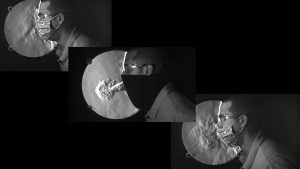From the Journal: Physics of Fluids
WASHINGTON, November 10, 2020 — If you have seen someone wandering around the grocery store or elsewhere with a mask with a valve on it and wondered how safe it is for you, you were right to be concerned.
Matthew Staymates, a mechanical engineer and fluid dynamicist at the National Institute of Standards and Technology, is studying different mask types to determine which are the most effective at reducing disease transmission.
In Physics of Fluids, from AIP Publishing, he describes exploring the basic flow dynamics of N95 masks with or without exhalation valves. To do this, he generates stunning video from his schlieren imaging, a method to visualize the fluid flow away from the surface of an object, and light scattering.
An exhalation valve on N95 masks is designed to improve the user comfort by reducing filtration resistance during exhalation.
“It’s basically a little flap that opens up when exhaling, which lets air out without being filtered through the mask material,” Staymates said. “I was able to visually show how this exhalation valve operates and compared it to an N95 that doesn’t have this valve.”
Staymates said his research showed N95 masks with an exhalation valve are not appropriate masks for filtering out respiratory droplets exiting a person.
“Our current understanding is that COVID-19 is transmitted in part via respiratory droplets, so N95s with valves are not good for source control during this pandemic,” he said.
He found N95 masks without valves are effective at blocking most droplets from penetrating through the mask material.
Staymates built an elaborate stay-at-home lab within his woodshop to put different mask types and materials to the test. He created an artificial exhalation system to mimic the exhale flow pattern of a real human and a custom pneumotachograph to measure his own breathing flow profile. He used this data as a standard for the artificial exhale system.

“I also designed and built a custom fog generator inside a mannequin head, which provides fog droplets that resemble closely the droplets that humans expire,” Staymates said. “The mannequin head exhales like me, and the fog generator essentially makes it look like it just took a cigarette puff.”
Using schlieren imaging and other flow visualization techniques “will continue to assist our efforts to better understand how masks and face coverings play a role in this disease transmission,” he said. “My hope is that this work will help inform a large audience that valves on a mask are not helpful as we fight this global pandemic together.”
###
For more information:
Larry Frum
media@aip.org
301-209-3090
Article Title
Authors
Matthew Staymates
Author Affiliations
National Institute of Standards and Technology
